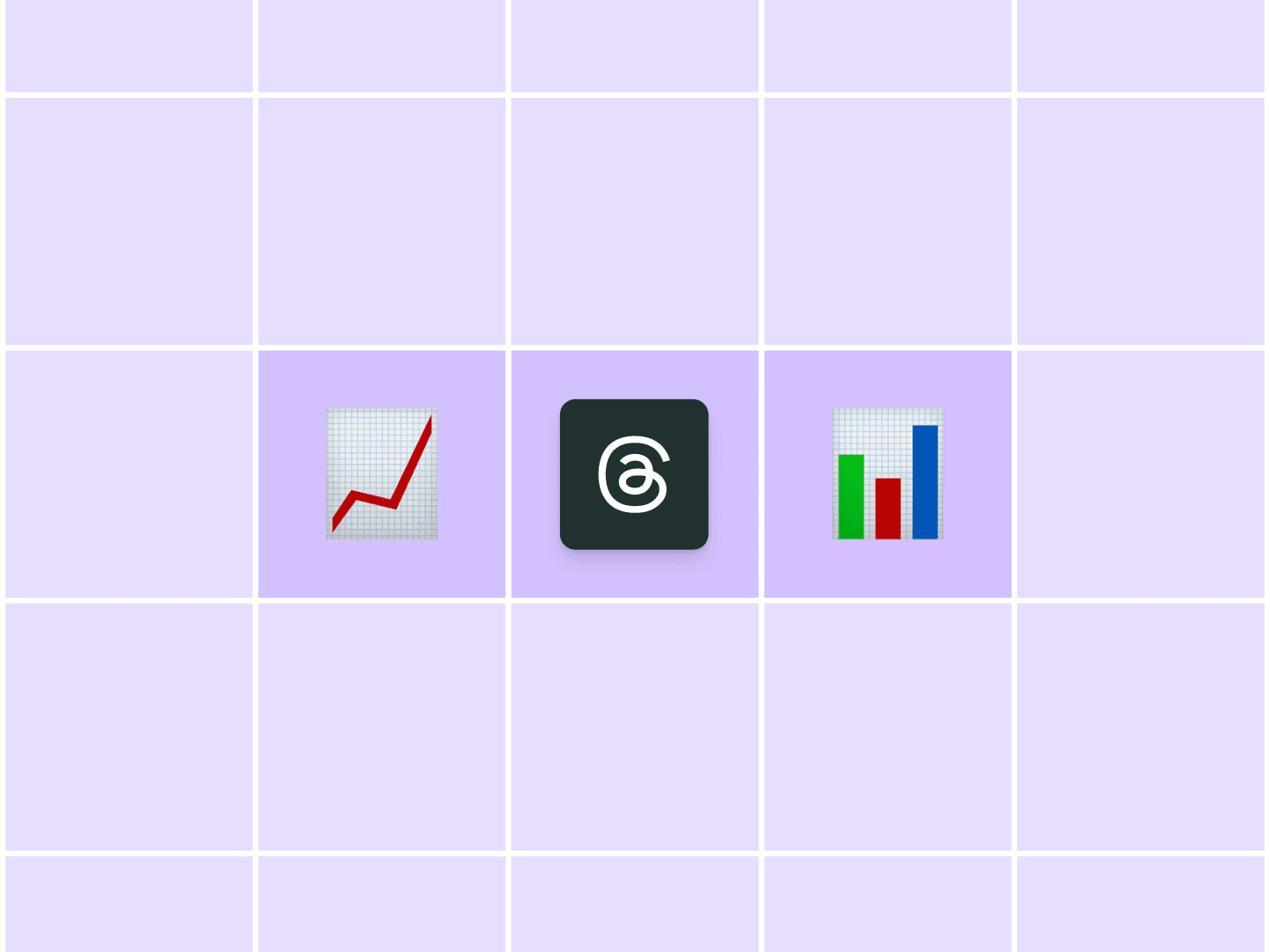Ever since Meta officially launched Threads, there has been a lot of speculation about which approach to content gets the best results. So, instead of just speculating, I decided to put some extra time and effort into posting to Threads consistently for a month.
Now, what does it say about me (or Threads) that my top-performing posts from the last 30 days were:
- A “What’s in my bag?” inspired by another post
- A reply to someone about how we create Human User Guides at Buffer?
I’m genuinely interested in your thoughts, so let me know in the comments!
But that’s just one fascinating part of one month of consistent posting, and not what I expected when I set out to see what would happen if I committed to posting consistently on Threads. Like many creators, I’ve been curious about this platform's potential and how it could fit into my personal content strategy.
The results were surprising — some wins, some misses, and a few unexpected insights I’ll carry into my future social media planning.
Let’s dive into the good, the challenging, and the lessons learned during my 30-day Threads experiment.
Why I chose to do this experiment on Threads
When Meta launched Threads, it immediately sparked my interest. While video-first platforms like Instagram and TikTok have dominated the social media landscape, Threads offered something refreshing: a place to engage in real, conflict-free conversations from a company with a historical focus on visual content.
As someone who thrives in community building and meaningful interaction, I saw an opportunity – and Threads seemed like the perfect place to test new approaches. The simplicity and conversational focus of the app were appealing, and it was the perfect ground to experiment with a different type of social engagement.
Keeping it simple and consistent
The rules were straightforward: I would post consistently for 30 days from August 12 to September 12, aiming to engage with the community by sharing thoughts, asking questions, and responding to others.
There wasn’t a specific niche I was focusing on — the goal was to test if consistency alone could generate growth and valuable interactions.
Along the way, I kept track of my activity, prioritizing a mix of text-based content, questions, and commentary on trends or personal experiences. I also made sure to track my content with tags in Buffer.
Of course, this challenge isn’t perfect. For one, I didn’t have any particular posting schedule prior to the 30 days of the experiment, so I have nothing to compare my performance to. Additionally, Threads doesn’t yet have robust analytics, so I’m taking a theoretical approach to analyzing the results from this project.
However, I still think there are valuable lessons to be learned from this project, so let’s get into it.
What I posted to Threads
As I stated, I hadn’t been particularly active with posting to Threads before this experiment, but my announcement of my #30ThreadDays project received the most comments of anything shared before or after.
Post by @tamioladipoView on Threads
My content strategy mostly consisted of posting “lifestyle” content with a sprinkling of content centered around my professional and side projects. I went this route because this type of content fills my feed and is what I enjoy consuming.

Also, since my Threads account wasn’t established prior to this experiment, and I wasn’t sure how much visibility my content would get, I stuck with safe, easy-to-execute formats.
A breakdown of the metrics
Between native Insights, a new Threads feature rolled out during the period of the experiment, Buffer’s post analytics, and this officially approved analytics platform, I was able to estimate the performance of my content.
Overall, my post views and engagement fluctuated over the 30 days, seemingly at the whims of the Threads algorithm. However, as I engaged more with others and made sure to respond promptly to replies, I noticed that consistent posting started to build small but noticeable momentum.
The most eye-popping metric is views – my content got 13,793 views. These are the number of eyeballs on my content, a significant jump (over 850 percent) from the previous 30-day period. Some other interesting metrics include:
- 233 likes (+1356 percent from the last period)
- 37 replies (+311 percent)
- 9 reposts (+800 percent)
- 2 quotes (+100 percent)
My follower count also grew, going from 267 to 290 in 30 days – not a significant jump, but not the worst outcome. While the engagement isn’t the most impressive, it’s also not the focus of Threads – replies and comments are. In that regard, I can say that I definitely saw more of those.
What worked (and what didn’t)
The first few days of the experiment were a whirlwind. I wasn’t an active Threads user before, so I wasn’t sure how much visibility my content would get. However, my announcement post for the #30ThreadDays project did surprisingly well, generating significant engagement, as did the following post.
As I continued posting, my visibility varied. Some days, my posts barely gained traction, while other days, I noticed a spike in engagement. While mildly frustrating, this fluctuation gave me some key insights into how the platform works and how its audience interacts with content.
Open-ended questions outperform any other type of content
A recent experiment found that questions generate more reach than any other type of content on Threads. Specifically, posts that invited conversation or shared an open-ended thought performed better than static updates or reposts from other platforms.
However, I’ll take that a step further and share that, in my experience, posts that were comments on or replies to questions did the best. For example, a simple reply to someone about how we create Human User Guides at Buffer generated my second-highest engagement rate.
Post by @tamioladipoView on Threads
Interestingly, quoting a post to share my reply didn’t really do any better or show up any differently for me. But replies did much better.
Post by @tamioladipoView on Threads
We can assume that’s because adding onto a post that already has traction is a surefire way to get the engagement ball rolling.
This discovery is nothing new – other users of Threads on the Buffer team have found a lot of success jumping into the comments.
Timeliness sparks engagement
Another win was timely commentary. Whenever I commented on a trend or hot topic, I saw a noticeable boost in replies and profile views. However, this isn’t restricted to just what’s in the news.
My top-performing post from the 30-day duration of this experiment was me replicating a format I had seen and liked, then tagging the original creator.
Post by @tamioladipoView on Threads
This was a clear sign that being part of the conversation in real-time mattered.
I also learned that engagement begets more engagement. Responding promptly to comments on my posts helped keep the conversation going and boosted my visibility even further. The more you put into Threads, the more you get out of it.
Prioritize visual content – but not video
Threads says it’s a text platform, but it showed its Instagram roots in its prioritization of engaging graphic content – a sentiment shared by other Threads users at Buffer. My amateur-ish Canva graphics consistently outperformed text posts – but interestingly, videos didn’t do any worse or better than text.
Post by @tamioladipoView on Threads
I don’t know if it was me or my approach, but none of the video content I posted did particularly well. That doesn’t mean video doesn’t work at all – it just didn’t work for me.
So, until the Threads team explicitly states that they’re prioritizing video, save your creative energy for fun graphics and insightful questions.
What didn’t work so well
However, not everything was smooth sailing. A few lessons stood out:
- Niche-less posting didn’t resonate: When I posted without a clear direction or focus (like a job posting in the middle of my lifestyle content), engagement was inconsistent. Threads seems to thrive on niches, even if they are broad, so the lack of a specific focus for my content meant it didn’t always hit the mark. Lesson learned: Consistency is important, but having a focused niche makes a bigger impact.
- Too much repurposed content: While cross-posting can be a time-saver, I noticed that content directly brought over from other platforms didn’t perform as well as original, platform-specific posts. Threads has its own vibe, and I’ll be focusing more on content tailored to the platform moving forward. Lesson learned: Threads has its own vibe — content tailored for the platform will always perform better than repurposed material.
My final lesson might just be conjecture, but I wanted to share anyway. Don’t be the first reply in your thread. For a platform called Threads, I noticed a pattern of posts that had follow-ups performing poorly.
So, keep your text post to the main box and if you must, add a visual with more text.
Moving forward with Threads
After 30 days of consistent posting on Threads, the biggest takeaway is that community and conversation are at the heart of this platform. Unlike Instagram or Twitter, where viral moments can drive a lot of the engagement, Threads rewards consistent, meaningful interaction over time.
Would I keep posting every day? Probably not — the daily commitment is intense, and I’ll likely switch to a few times a week to focus on quality over quantity. However, the experience confirmed that Threads has a lot of potential, especially for creators and brands looking to engage deeply with their audience.
Going forward, I plan to:
- Narrow down my content focus to build a more targeted niche on Threads. I have many things to talk about, but I’ll save that for platforms like X where I’m not as concerned about growth.
- Continue using Threads as a conversational space, prioritizing discussions and open-ended questions.
- Share platform-specific content instead of repurposing posts from other platforms.
Do you want to post to Threads more consistently? Try scheduling out your posts in Buffer, and grab these prompts to help you get started.
Try Buffer for free
190,000+ creators, small businesses, and marketers use Buffer to grow their audiences every month.





